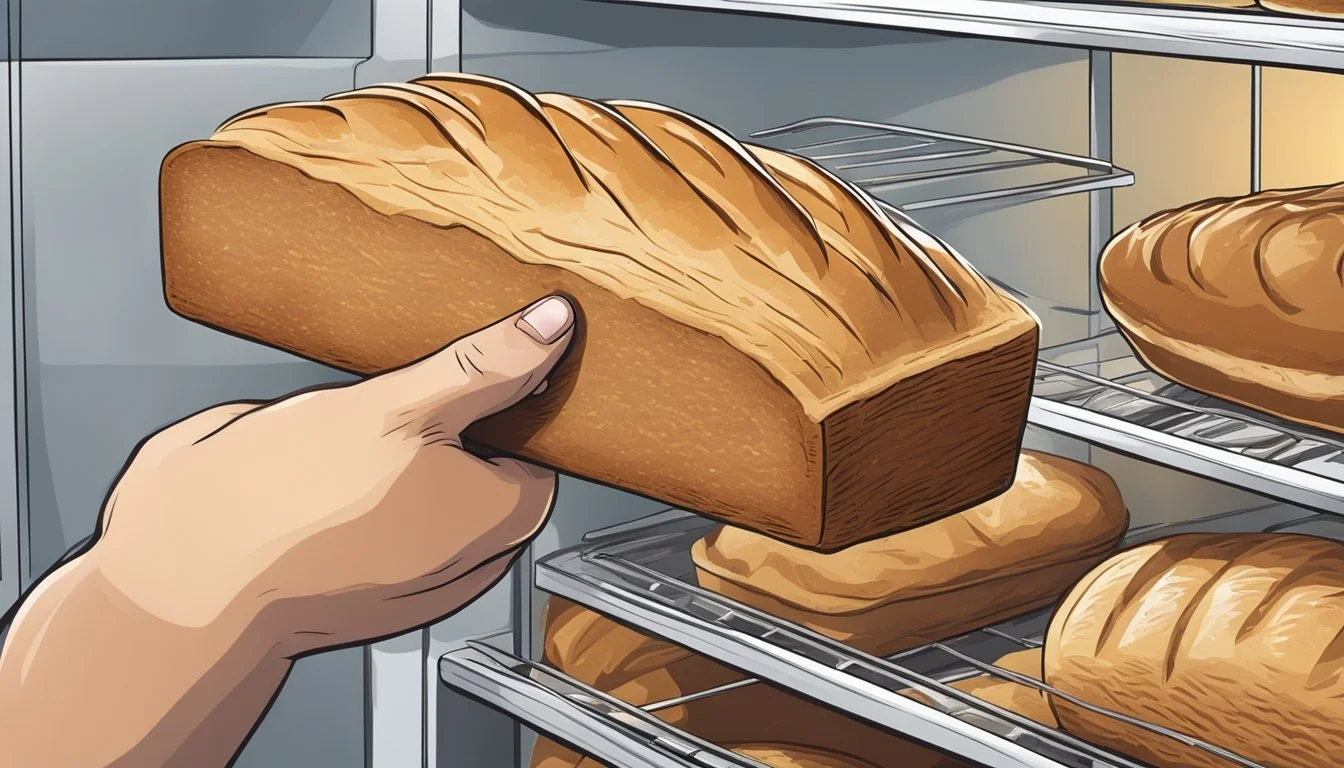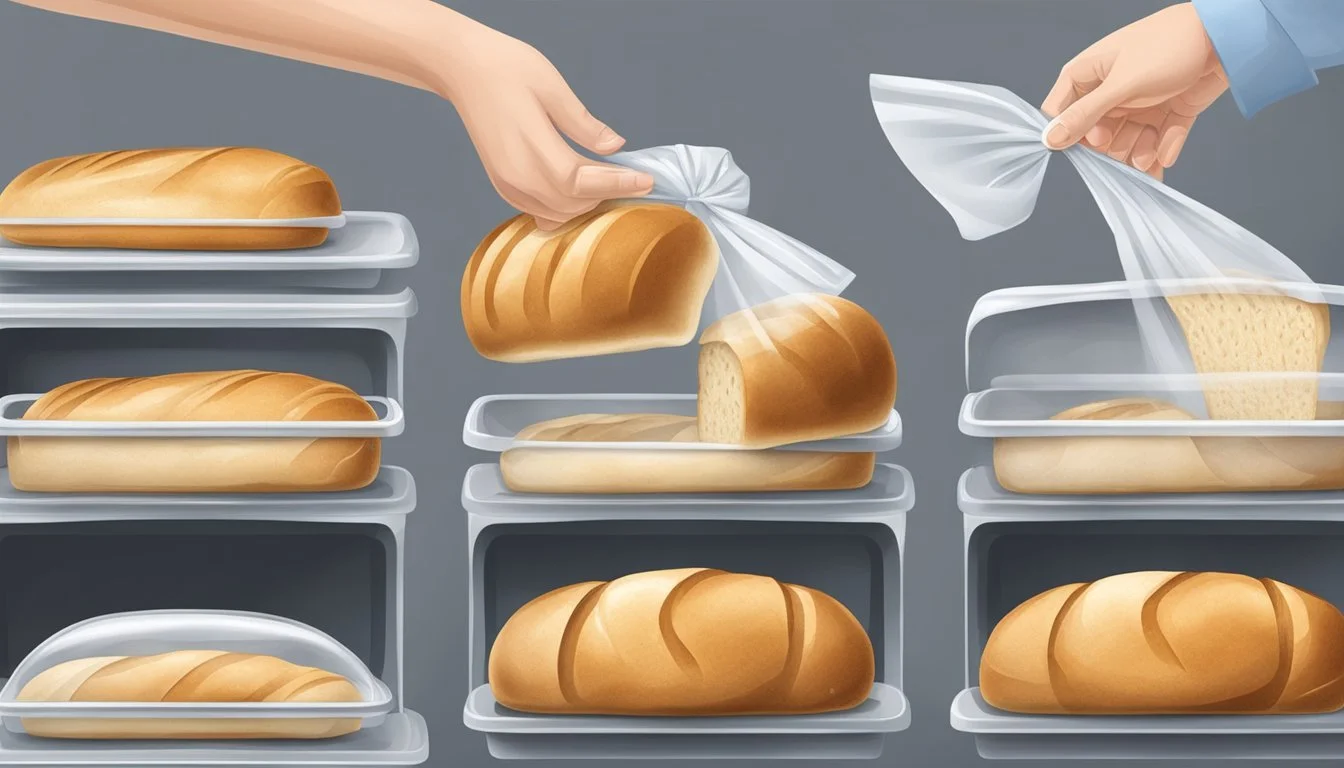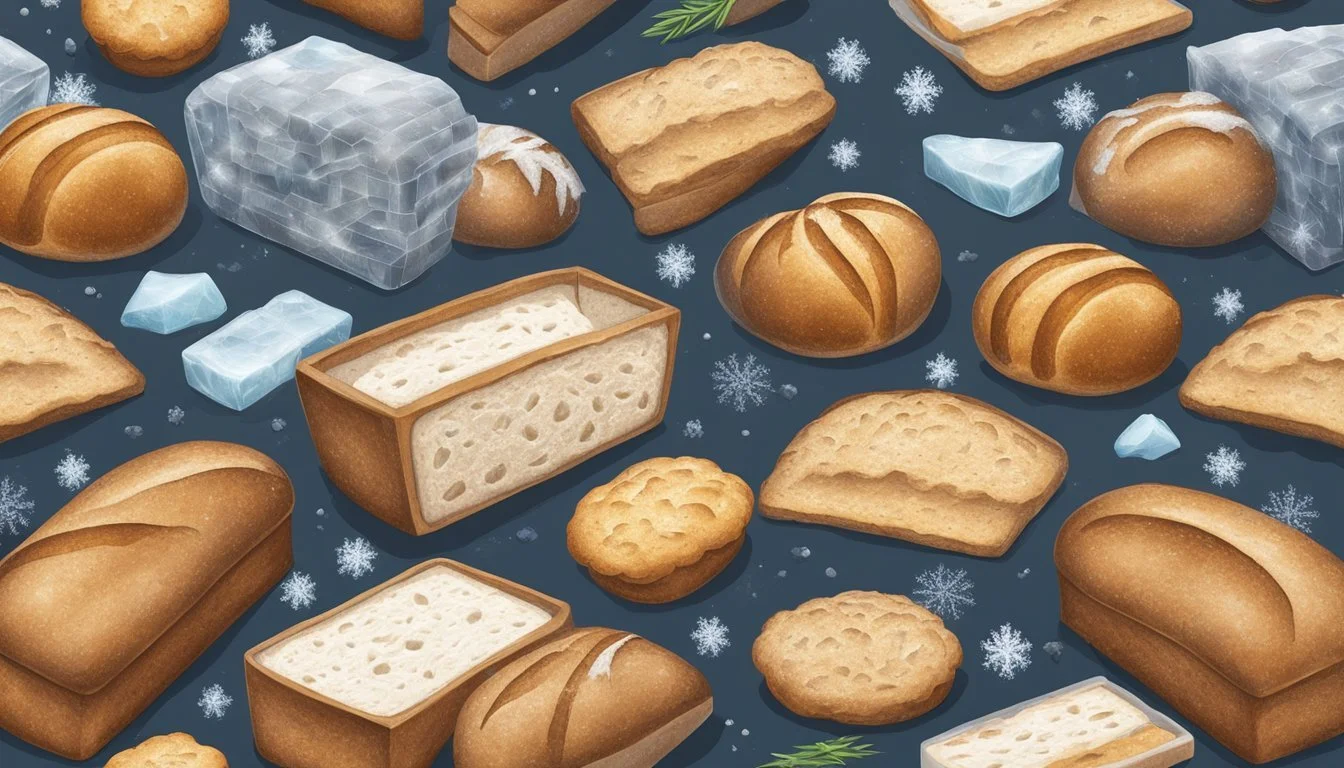How to Freeze Bread Without Sacrificing Texture
Expert Tips for Perfect Results
Freezing bread is a practical approach to extending its shelf life, allowing one to enjoy fresh-tasting bread beyond the counter or refrigerator's limited keeping time. The key to maintaining a bread's texture during freezing lies in preventing moisture loss and ice crystal formation, which can lead to sogginess or dryness upon thawing. Properly freezing bread ensures that the texture remains as close to fresh as possible, making it a convenient solution for preserving loaves, rolls, and slices.
Achieving the right technique for freezing bread involves attention to detail before it even hits the cold air of the freezer. It is essential to allow the bread to cool completely, as wrapping warm bread can trap steam and promote mold growth. Once cool, the bread should be wrapped securely to minimize exposure to air, which is the culprit behind freezer burn and textural degradation. This careful preparation helps maintain quality and taste, setting the stage for a satisfying experience when it's time to thaw and consume the bread.
The process of wrapping the bread requires precision; too loose, and the bread will suffer from frost and off-flavors, too tight, and condensation might build up. Depending on the size and type of bread, different methods such as using plastic wrap, aluminum foil, or resealable plastic bags may be employed. For sliced bread, one might consider freezing individual slices to make single servings more accessible. This attention to packaging is paramount in preserving the soft crumb and crisp crust that freshly baked bread boasts.
Why Freeze Bread?
Freezing bread is a practical method to extend its shelf-life while maintaining freshness. When consumers buy or bake bread in bulk, they often face a common conundrum: how to enjoy it before it becomes stale or succumbs to mold. Freezing offers an ideal solution.
Preservation of Freshness: Freshly baked bread has a limited window of peak freshness. Freezing bread halts the staling process, which begins as soon as the bread cools after baking. By storing it in the freezer, consumers can enjoy bread that tastes fresh for a longer period.
Extending Shelf-Life: At room temperature, bread typically remains at optimal quality for only a few days. In contrast, when properly frozen, bread can last for several weeks to months, drastically extending its usability.
Convenience: Having bread readily available in the freezer means there's always an option for a quick meal or snack. This is particularly useful for those with a busy lifestyle or for unexpected guests.
Preventing Waste: Bread is a staple that can often go unused and get discarded if not consumed promptly. Freezing bread is an efficient way to reduce food waste, as one can thaw only the slices needed, keeping the rest frozen for future use.
The following points summarize the rationale behind freezing bread:
Maintains Freshness: Freezing bread effectively preserves its just-baked taste.
Longer Shelf-Life: Bread can be kept for an extended period without degrading in quality.
Convenience: Frozen bread provides a quick and easy option for meals.
Reduces Waste: Helps prevent bread from becoming stale or moldy, avoiding unnecessary waste.
Selecting the Right Bread for Freezing
The key to successfully freezing bread lies in choosing the appropriate type and preparing it properly before freezing. This ensures the texture and flavor remain as fresh as possible when thawed.
Types of Bread and Their Freezing Characteristics
Crusty Breads: Breads with a distinct crust, such as baguettes or sourdough, typically freeze well due to their lower moisture content. They are less likely to become soggy compared to softer breads.
Soft Breads: Softer breads, including most sandwich loaves, can be frozen but may require careful wrapping to prevent moisture loss and preserve texture.
Homemade Bread: As long as homemade bread is fresh and has not yet become stale, it freezes quite effectively. The absence of preservatives can mean a shorter shelf life, making freezing a beneficial method to extend freshness.
Sliced Bread: Pre-slicing bread before freezing allows for small portions to be thawed as needed, minimizing the need to thaw and refreeze, which can degrade quality.
Pre-Freezing Bread Considerations
Moisture Content: It's crucial to wrap bread tightly to keep out air and moisture, which can lead to freezer burn and affect texture. Plastic wrap followed by foil or freezer paper is effective.
Temperature Correction: Bread should be frozen at 0°F (-18°C) or below to ensure it stays frozen solid, maintaining its texture and preventing bacterial growth or spoilage.
Freezing Methods:
Quick Freezing: If available, utilizing a quick-freeze setting on the freezer accelerates the freezing process, helping to preserve the texture and flavor of the bread.
Gradual Cooling: Allowing homemade bread to cool completely before freezing prevents condensation and subsequent ice crystal formation, which can negatively impact texture upon thawing.
Preparing Bread for Freezing
Before freezing bread, one must ensure that the bread is cooled completely and sliced according to preference. Bread must be protected properly to preserve its texture and flavor during storage.
Slicing Bread
Fresh Bread: It should be cooled completely because slicing warm bread can cause undue moisture, which leads to ice crystals and impacts the texture negatively.
Slices: Cut the bread into even slices if one plans to use individual pieces later. This assists in defrosting only what is needed and keeps the rest of the bread frozen.
Wrapping and Protecting Bread
Plastic Wrap: Each slice should be wrapped tightly in plastic wrap. This helps to prevent freezer burn and stave off absorbing odors.
Aluminum Foil: Alternatively, aluminum foil can be used to wrap slices or a whole loaf, which should then be placed in a bread bag or freezer-safe container.
Bread Bag: For additional protection, the wrapped slices or loaf can be placed in a bread bag, squeezing out as much air as possible before sealing to minimize the risk of moisture build-up and freezer burn.
Proper Freezing Techniques
When freezing bread, one should focus on maintaining the right temperature and proper storage methods to preserve its quality. These steps can prevent common issues such as freezer burn and texture degradation.
Freezer Management
To ensure bread retains its texture after freezing, one must manage the freezer effectively. The freezer should be maintained at 0°F (-18°C) or lower, which is the optimal temperature for freezing food. Using a thermometer to regularly check the freezer's temperature is crucial for consistency. It's also important to date the bread upon freezing, using a label or a piece of tape with the current date. This helps in keeping track of the bread's longevity and ensures it is used within a reasonable time frame.
Avoiding Freezer Burn
Freezer burn occurs when air reaches the bread's surface, leading to dry spots and off flavors. To avoid this:
Pre-wrap the bread: It's beneficial to wrap bread slices or loaves tightly in cling film or aluminum foil first, making sure all parts are covered.
Use air-tight containers or bags: Place the wrapped bread into air-tight freezer bags, squeezing out excess air before sealing.
Use portions: If one plans to use only parts of the bread at a time, consider pre-slicing before freezing. This allows one to thaw only the needed amount, reducing the bread's exposure to air.
Thawing and Reheating Frozen Bread
Ensuring that bread regains its original texture and warmth after freezing is essential for optimal enjoyment. This section discusses how to properly thaw and reheat frozen bread using various methods.
Thawing Bread at Room Temperature
For those who plan ahead, thawing bread at room temperature is the most straightforward method. Simply remove the bread from the freezer and leave it in its original wrapping on the countertop. The time needed can vary:
Slices of bread may take 30 minutes to 1 hour.
Whole loaves might require 2-4 hours depending on size.
Using the Oven or Toaster
To reheat frozen bread in the oven or toaster, one should keep a keen eye on temperature and timing to prevent drying out or burning:
Oven Method:
Preheat the oven to 350°F (175°C).
For sliced bread, place directly on a baking sheet; wrap whole loaves in aluminum foil.
Heat slices for 5-10 minutes and whole loaves for up to 20 minutes.
Place frozen bread slices directly into the toaster.
Toast on a medium setting until the desired crispness is achieved.
Quick Thawing Techniques
When time is of the essence, these techniques can come in handy for one to quickly enjoy their bread:
Microwave: Encase a slice of bread in a paper towel and heat on high for about 30 seconds.
Running Water: To quickly defrost a slice, lightly dampen the underside of the bread with running water and immediately heat in a toaster or oven at 400°F.
Each method serves to ensure that the bread is not only thawed but also returns to a pleasing texture and temperature for consumption. Complete thawing prior to heating is critical in preserving the bread's quality.
Best Practices for Long-Term Storage
Freezing bread is an excellent method to maintain its quality over time. For optimal results, one should freeze bread when it is at its freshest. Preparation is key: before freezing, the bread must be wrapped tightly to avoid air exposure which leads to freezer burn.
Firstly, double-wrap the bread using plastic wrap as the initial layer, ensuring it's sealed completely. Then proceed with a second layer which can involve aluminum foil or freezer paper. This secondary wrapping defends against freezer odors and further protects the bread's texture.
For convenience, pre-slice the bread before freezing. This enables one to thaw only the desired amount without needing to defrost the entire loaf. When wrapping, remove as much air as possible from the wrapping material to limit moisture buildup.
Employ a freezer bag to store sliced bread, rolls, or buns. Squeeze out extra air and seal tightly. This method is especially recommended for bread varieties that contain seeds, as it helps preserve their crunchiness upon defrosting.
Label the package with the date of freezing. Bread can be stored in the freezer safely for several months, so a date ensures awareness of its longevity.
Temperature plays a critical role. The freezer must be at 0°F (-18°C) or below, which is the ideal temperature to halt bacterial growth and keep bread in a stable frozen state.
To enjoy, select slices as needed and either toast or warm in the oven to revive the bread's texture and warmth. Toasting can crisp the crust and tenderize the crumb for an enjoyable consumption experience.
Creative Uses for Frozen Bread
Frozen bread need not only be reserved for toasting. It can be an invaluable ingredient in various recipes, maintaining its taste and texture even after freezing.
Making French Toast from Frozen Bread
French toast is a classic breakfast dish that benefits from the use of frozen bread. Frozen slices easily soak up the egg mixture without becoming too soggy. The key is to dip each piece long enough to absorb the flavors, but not too long that the bread falls apart. One can proceed by frying these slices until they have a golden-brown exterior with a soft, custardy inside.
Croutons and Bread Crumbs
Frozen bread can be transformed into crunchy croutons for salads or soups. Simply cube the bread, toss it with oil, seasoning, and bake until crispy. Additionally, one can make bread crumbs by toasting the bread before pulsing it in a food processor. These home-made bread crumbs are perfect for adding texture to dishes like meatballs, casseroles, or as a topping for macaroni and cheese.
Sandwiches with Frozen Bread
Sandwiches benefit from frozen bread, as the bread holds its shape better and can contain moist ingredients without turning soggy. Simply layer the desired fillings between two slices of frozen bread, and by lunchtime, the bread will have thawed, leaving the sandwich fresh and ready to eat. For hot sandwiches like melts or paninis, frozen bread can provide a crispier texture when grilled or pressed.
Troubleshooting Common Freezing Issues
When freezing bread, it's essential to prevent mold growth and retain the bread's moisture to avoid dryness upon thawing. The following tips address these concerns effectively.
Dealing with Mold on Frozen Bread
If one notices mold on their frozen bread, it invariably traces back to moisture issues before freezing. Bread must be completely cool prior to freezing to prevent condensation, which can create a breeding ground for mold. If bread is frozen with apparent moisture, mold can develop, rendering the bread unsafe to eat.
To salvage bread that is not thoroughly spoiled by mold, one must discard any moldy slices and check carefully for further contamination. If the remainder of the loaf appears unaffected, the bread should be consumed immediately after thawing, though the safest option is always to dispose of any bread with mold to avoid possible health risks.
Reviving Dry, Frozen Bread
Bread can become dry in the freezer if it's not wrapped properly. To thaw bread and revive its initial texture, follow these steps:
Place the bread at room temperature in its original wrapping or in a piece of cling film. This method helps to retain the bread's moisture while it defrosts.
For sliced bread, individual pieces can be defrosted by placing them on a plate under cling film at room temperature or using a toaster.
To rejuvenate the crust's crispness post-thawing, briefly reheat the bread in an oven at 300-350 F for a short period. This can restore the bread's original texture and can be particularly effective for artisanal breads with a significant crust.
Alternative Freezing Options
In ensuring the integrity of baked goods' texture after freezing, one should consider the specific nature of the item and the techniques employed.
Freezing Different Baked Goods
Muffins and Cornbread:
Muffins can maintain moisture when frozen individually after cooling. Wrapping each muffin in parchment paper before placing it in a hard-sided container will prevent freezer burn and preserve texture.
Cornbread is best frozen as a whole slab or in slices, wrapped in aluminum foil, and kept in an airtight container to retain its crumbly nature.
Banana Bread:
Freeze banana bread by first letting it cool completely. Wrap the loaf in a layer of parchment paper followed by a layer of foil to protect against freezer air while maintaining its moist texture.
Bagels:
Bagels should be sliced before freezing to allow for easier toasting or reheating. Wrap each half individually in parchment or wax paper, then place them in a freezer-safe container or silicone bag.
Freezing Sliced Bread:
Sliced bread can be frozen directly in its original packaging if it is unopened and air-tight or transferred to a silicone bag. Place a piece of parchment paper between each slice to prevent sticking, allowing for single slices to be removed without defrosting the entire loaf.
Partial Freezing Techniques
Partial freezing is useful for breads that don't freeze well whole.
Pre-slicing: For loaves like banana bread, pre-slice and partially freeze the slices on a baking sheet before transferring them to a container or wrap. This keeps slices from sticking together.
Flash freezing: Bagels and sliced bread benefit from flash freezing on a baking sheet before storing them in their final freezing container or wrap. This technique maintains their shape and texture.






